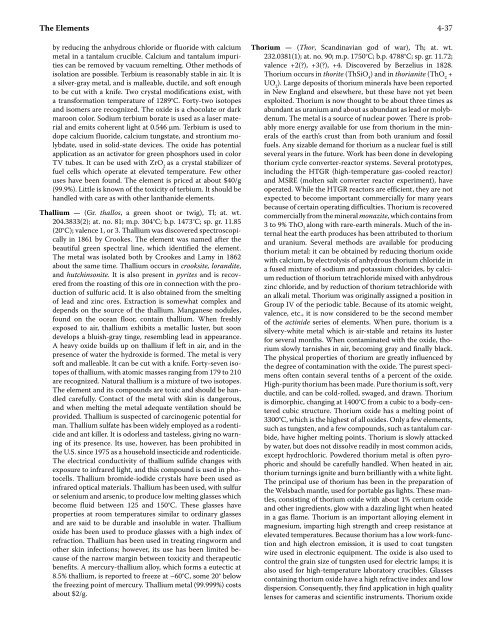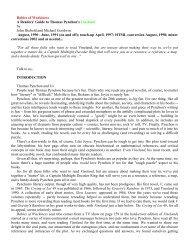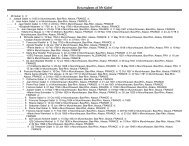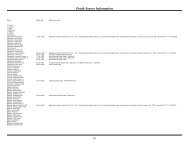CRC Handbook of Chemistry and Physics, 86th Edition
CRC Handbook of Chemistry and Physics, 86th Edition
CRC Handbook of Chemistry and Physics, 86th Edition
Create successful ePaper yourself
Turn your PDF publications into a flip-book with our unique Google optimized e-Paper software.
The Elements 4-37<br />
by reducing the anhydrous chloride or fluoride with calcium<br />
metal in a tantalum crucible. Calcium <strong>and</strong> tantalum impurities<br />
can be removed by vacuum remelting. Other methods <strong>of</strong><br />
isolation are possible. Terbium is reasonably stable in air. It is<br />
a silver-gray metal, <strong>and</strong> is malleable, ductile, <strong>and</strong> s<strong>of</strong>t enough<br />
to be cut with a knife. Two crystal modifications exist, with<br />
a transformation temperature <strong>of</strong> 1289°C. Forty-two isotopes<br />
<strong>and</strong> isomers are recognized. The oxide is a chocolate or dark<br />
maroon color. Sodium terbium borate is used as a laser material<br />
<strong>and</strong> emits coherent light at 0.546 µm. Terbium is used to<br />
dope calcium fluoride, calcium tungstate, <strong>and</strong> strontium molybdate,<br />
used in solid-state devices. The oxide has potential<br />
application as an activator for green phosphors used in color<br />
TV tubes. It can be used with ZrO 2 as a crystal stabilizer <strong>of</strong><br />
fuel cells which operate at elevated temperature. Few other<br />
uses have been found. The element is priced at about $40/g<br />
(99.9%). Little is known <strong>of</strong> the toxicity <strong>of</strong> terbium. It should be<br />
h<strong>and</strong>led with care as with other lanthanide elements.<br />
Thallium — (Gr. thallos, a green shoot or twig), Tl; at. wt.<br />
204.3833(2); at. no. 81; m.p. 304°C; b.p. 1473°C; sp. gr. 11.85<br />
(20°C); valence 1, or 3. Thallium was discovered spectroscopically<br />
in 1861 by Crookes. The element was named after the<br />
beautiful green spectral line, which identified the element.<br />
The metal was isolated both by Crookes <strong>and</strong> Lamy in 1862<br />
about the same time. Thallium occurs in crooksite, lor<strong>and</strong>ite,<br />
<strong>and</strong> hutchinsonite. It is also present in pyrites <strong>and</strong> is recovered<br />
from the roasting <strong>of</strong> this ore in connection with the production<br />
<strong>of</strong> sulfuric acid. It is also obtained from the smelting<br />
<strong>of</strong> lead <strong>and</strong> zinc ores. Extraction is somewhat complex <strong>and</strong><br />
depends on the source <strong>of</strong> the thallium. Manganese nodules,<br />
found on the ocean floor, contain thallium. When freshly<br />
exposed to air, thallium exhibits a metallic luster, but soon<br />
develops a bluish-gray tinge, resembling lead in appearance.<br />
A heavy oxide builds up on thallium if left in air, <strong>and</strong> in the<br />
presence <strong>of</strong> water the hydroxide is formed. The metal is very<br />
s<strong>of</strong>t <strong>and</strong> malleable. It can be cut with a knife. Forty-seven isotopes<br />
<strong>of</strong> thallium, with atomic masses ranging from 179 to 210<br />
are recognized. Natural thallium is a mixture <strong>of</strong> two isotopes.<br />
The element <strong>and</strong> its compounds are toxic <strong>and</strong> should be h<strong>and</strong>led<br />
carefully. Contact <strong>of</strong> the metal with skin is dangerous,<br />
<strong>and</strong> when melting the metal adequate ventilation should be<br />
provided. Thallium is suspected <strong>of</strong> carcinogenic potential for<br />
man. Thallium sulfate has been widely employed as a rodenticide<br />
<strong>and</strong> ant killer. It is odorless <strong>and</strong> tasteless, giving no warning<br />
<strong>of</strong> its presence. Its use, however, has been prohibited in<br />
the U.S. since 1975 as a household insecticide <strong>and</strong> rodenticide.<br />
The electrical conductivity <strong>of</strong> thallium sulfide changes with<br />
exposure to infrared light, <strong>and</strong> this compound is used in photocells.<br />
Thallium bromide-iodide crystals have been used as<br />
infrared optical materials. Thallium has been used, with sulfur<br />
or selenium <strong>and</strong> arsenic, to produce low melting glasses which<br />
become fluid between 125 <strong>and</strong> 150°C. These glasses have<br />
properties at room temperatures similar to ordinary glasses<br />
<strong>and</strong> are said to be durable <strong>and</strong> insoluble in water. Thallium<br />
oxide has been used to produce glasses with a high index <strong>of</strong><br />
refraction. Thallium has been used in treating ringworm <strong>and</strong><br />
other skin infections; however, its use has been limited because<br />
<strong>of</strong> the narrow margin between toxicity <strong>and</strong> therapeutic<br />
benefits. A mercury-thallium alloy, which forms a eutectic at<br />
8.5% thallium, is reported to freeze at –60°C, some 20° below<br />
the freezing point <strong>of</strong> mercury. Thallium metal (99.999%) costs<br />
about $2/g.<br />
Thorium — (Thor, Sc<strong>and</strong>inavian god <strong>of</strong> war), Th; at. wt.<br />
232.0381(1); at. no. 90; m.p. 1750°C; b.p. 4788°C; sp. gr. 11.72;<br />
valence +2(?), +3(?), +4. Discovered by Berzelius in 1828.<br />
Thorium occurs in thorite (ThSiO 4 ) <strong>and</strong> in thorianite (ThO 2 +<br />
UO 2 ). Large deposits <strong>of</strong> thorium minerals have been reported<br />
in New Engl<strong>and</strong> <strong>and</strong> elsewhere, but these have not yet been<br />
exploited. Thorium is now thought to be about three times as<br />
abundant as uranium <strong>and</strong> about as abundant as lead or molybdenum.<br />
The metal is a source <strong>of</strong> nuclear power. There is probably<br />
more energy available for use from thorium in the minerals<br />
<strong>of</strong> the earth’s crust than from both uranium <strong>and</strong> fossil<br />
fuels. Any sizable dem<strong>and</strong> for thorium as a nuclear fuel is still<br />
several years in the future. Work has been done in developing<br />
thorium cycle converter-reactor systems. Several prototypes,<br />
including the HTGR (high-temperature gas-cooled reactor)<br />
<strong>and</strong> MSRE (molten salt converter reactor experiment), have<br />
operated. While the HTGR reactors are efficient, they are not<br />
expected to become important commercially for many years<br />
because <strong>of</strong> certain operating difficulties. Thorium is recovered<br />
commercially from the mineral monazite, which contains from<br />
3 to 9% ThO 2 along with rare-earth minerals. Much <strong>of</strong> the internal<br />
heat the earth produces has been attributed to thorium<br />
<strong>and</strong> uranium. Several methods are available for producing<br />
thorium metal: it can be obtained by reducing thorium oxide<br />
with calcium, by electrolysis <strong>of</strong> anhydrous thorium chloride in<br />
a fused mixture <strong>of</strong> sodium <strong>and</strong> potassium chlorides, by calcium<br />
reduction <strong>of</strong> thorium tetrachloride mixed with anhydrous<br />
zinc chloride, <strong>and</strong> by reduction <strong>of</strong> thorium tetrachloride with<br />
an alkali metal. Thorium was originally assigned a position in<br />
Group IV <strong>of</strong> the periodic table. Because <strong>of</strong> its atomic weight,<br />
valence, etc., it is now considered to be the second member<br />
<strong>of</strong> the actinide series <strong>of</strong> elements. When pure, thorium is a<br />
silvery-white metal which is air-stable <strong>and</strong> retains its luster<br />
for several months. When contaminated with the oxide, thorium<br />
slowly tarnishes in air, becoming gray <strong>and</strong> finally black.<br />
The physical properties <strong>of</strong> thorium are greatly influenced by<br />
the degree <strong>of</strong> contamination with the oxide. The purest specimens<br />
<strong>of</strong>ten contain several tenths <strong>of</strong> a percent <strong>of</strong> the oxide.<br />
High-purity thorium has been made. Pure thorium is s<strong>of</strong>t, very<br />
ductile, <strong>and</strong> can be cold-rolled, swaged, <strong>and</strong> drawn. Thorium<br />
is dimorphic, changing at 1400°C from a cubic to a body-centered<br />
cubic structure. Thorium oxide has a melting point <strong>of</strong><br />
3300°C, which is the highest <strong>of</strong> all oxides. Only a few elements,<br />
such as tungsten, <strong>and</strong> a few compounds, such as tantalum carbide,<br />
have higher melting points. Thorium is slowly attacked<br />
by water, but does not dissolve readily in most common acids,<br />
except hydrochloric. Powdered thorium metal is <strong>of</strong>ten pyrophoric<br />
<strong>and</strong> should be carefully h<strong>and</strong>led. When heated in air,<br />
thorium turnings ignite <strong>and</strong> burn brilliantly with a white light.<br />
The principal use <strong>of</strong> thorium has been in the preparation <strong>of</strong><br />
the Welsbach mantle, used for portable gas lights. These mantles,<br />
consisting <strong>of</strong> thorium oxide with about 1% cerium oxide<br />
<strong>and</strong> other ingredients, glow with a dazzling light when heated<br />
in a gas flame. Thorium is an important alloying element in<br />
magnesium, imparting high strength <strong>and</strong> creep resistance at<br />
elevated temperatures. Because thorium has a low work-function<br />
<strong>and</strong> high electron emission, it is used to coat tungsten<br />
wire used in electronic equipment. The oxide is also used to<br />
control the grain size <strong>of</strong> tungsten used for electric lamps; it is<br />
also used for high-temperature laboratory crucibles. Glasses<br />
containing thorium oxide have a high refractive index <strong>and</strong> low<br />
dispersion. Consequently, they find application in high quality<br />
lenses for cameras <strong>and</strong> scientific instruments. Thorium oxide







